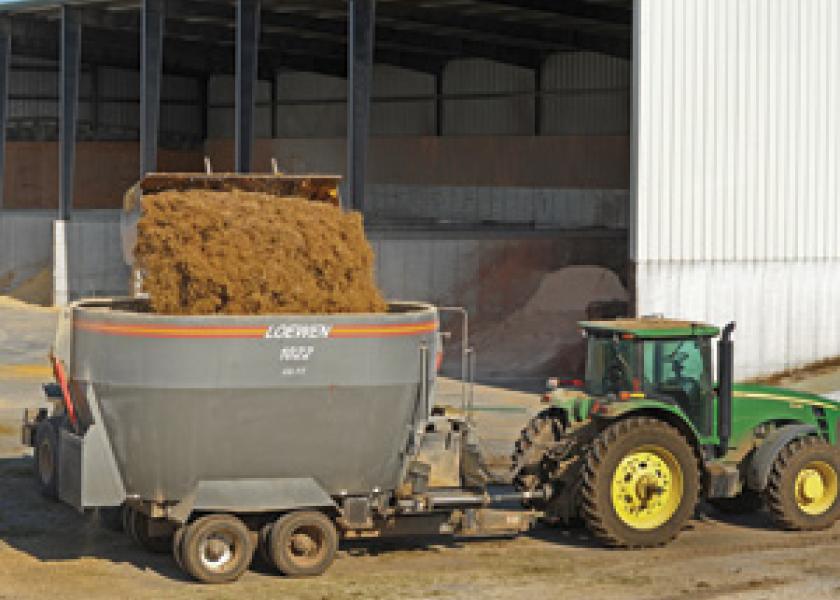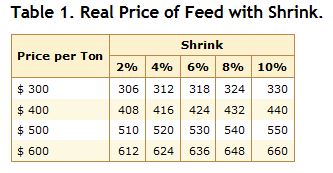Reduce Feed Costs with Commodity Storage

Commodity feeding can be a money saving or money losing game, and each farm needs to look at their numbers and make that decision for their operation.
The first questions to ask is "Why commodity feeding?" The usual answers are expected reduction in feeding costs, being able to customize the ration, making ‘opportunity’ purchases, and greater influence on the quality of the ration. While some or all of these may or can be true, commodity feeding also has a dark side. There is going to be a cost of commodity feeding. There is the cost of maintaining an inventory of ingredients, particularly if you buy large qualities of a feed that you feed out in very small amounts. There is the cost of labor to mix the feed and cost of management to make sure feed is on-hand when needed. Commodity feeding can be a money saving or money losing game, and each farm needs to look at their numbers and make that decision for their operation.
One of the largest costs of commodity feeding, and really feeding in general, that is often overlooked is dry matter loss or shrink. Simply put, shrink is the difference between the feed that is delivered to the storage, and the amount the cows get to use. With commodities, loss can range from 1% to 10% for dry ingredients or as high as 20% to 25% for wet ingredients.
Common causes we blame for dry matter loss or shrink are birds and rodents, loss to the environment due to rain and snow getting on the feed or wind blowing it away, spoilage losses or moisture loss during storage. However, there are two big ones that the farm management has control over. Spillage during feeding and overfeeding are result of operator error and mismanagement. Spillage is what I call the trail of feed left behind between the feed storage and the mixer. Things like how far you travel between the two, how full is the bucket of the loader, and what type of terrain you travel over can make a big difference in this number. Overfeeding is the difference between what the paper ration calls for and what really goes in the mixer.
Take a 500-cow herd for example that makes four mixes a day, with each mix having 1,000 pounds of protein in it at $500/ton. If each batch is overfed by 20 pounds, that’s a 2% loss due just to overfeeding! Or think if it as $20 per day or $7,300 per year for that farm. Now the real cost of that protein source becomes $510/ton rather than $500/ton. The ‘Real Price of Feed with Shrink’ is shown in the table below. Shrink is MONEY!!
 |
Now what about types of commodity storage? The two common types of storage are flat floor, open commodity sheds and upright bins. However, you also see gravity wagons, bags, piles, and other makeshift storages used on farms. The flat floor, open sheds have the advantage of being able to handle any type of feed, wet or dry, fluffy or dense, etc. They also make unloading trucks very easy and are fast to feed out. However, the cost of this is they come with a higher expected shrink due to weather exposure, losses to birds and rodents, and typically more overfeeding because a loader or skid-steer is used to remove feed. Characteristics of a good shed are they provide equipment clearance, have a 40- to 50-foot paved apron to the front, allow easy access and maneuvering of trucks, and are open away from prevailing weather.
Upright bins typically have a lower expected feed loss, because of being protected from weather and providing more accurate feed removal. Upright bins take up less space for the same tons of storage and are self unloading. However, they come at the cost of slower feed out and some feed ingredient types are just not compatible with bins. Also you need to think about how you are going to get the feed into the bin. Will the farm have their own auger or will the delivery truck have an auger or blower?
I would caution any farm to be extremely conscious of labor and dry matter loss when using any type of make-shift storage. The savings in capital costs up front may soon be lost to shrink in the long run.
It may be best to think of commodity storage as a system where a combination of both flat floor, open storage and upright bins are used. Different types of commodities can then be matched to the structure best suited to that commodity. Regardless of storage type, location also plays into shrink. Locating the storage near the forage storage makes for ‘one-stop shopping,’ and minimizes the movement of feeding equipment and the carrying of feed.
More information about "Feed Storage and Handling System Design" can be seen by watching the March 26, 2013 Technology Tuesday Webinar.
Additionally, read dairy and beef news to get all the latest news and updates.







